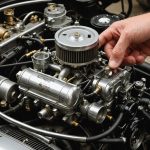Overview of Essential Safety Measures
Safety is paramount when dealing with high-performance brake systems and their alignment. Ensuring brake system safety requires meticulous attention to detail, as high-performance vehicles operate under conditions where failures could lead to catastrophic outcomes.
Alignment safety is equally critical, as improper alignment can degrade performance and increase the likelihood of accidents. Regular inspections and proper maintenance are essential to identify potential misalignments early. This prevents uneven wear on tyres and decreases stopping distances, enhancing overall vehicle control.
Topic to read : Mastering Headlight Alignment: A Step-by-Step Guide for Vintage Cars
Let’s delve into the common risks associated with brake systems. Poorly maintained brakes can lead to brake fade, decreased responsiveness, and, ultimately, a loss of control. To avert these hazards, it’s crucial to establish high-performance protocols that include routine checks, timely replacements, and ensuring that components meet the necessary standards.
Key principles in establishing safety protocols involve a systematic approach:
Also to read : Essential Safety Tips for Upgrading Your Vehicle with a Digital Dashboard
- Conduct regular inspections to identify wear and tear.
- Implement rigorous training for technicians handling these systems.
- Utilize quality parts designed specifically for high-performance applications.
By adhering to these principles, you not only enhance performance but also maintain the highest safety standards.
Safety Protocols for Testing High-Performance Brake Systems
Ensuring the safe operation of high-performance brake systems is vital. Safety protocols guide every step of brake system testing, from preparation to post-testing procedures.
Pre-Testing Safety Checks
Before testing, conduct comprehensive checks on all tools and equipment involved. This ensures they are in optimal condition for brake system testing. Assess the testing environment to identify and mitigate potential hazards, accounting for factors like adequate ventilation and stable ground for vehicle setup. Personnel safety is paramount; ensure that all involved wear the necessary safety gear, including helmets, gloves, and eye protection, to protect against potential dangers during testing.
On-Site Testing Considerations
During testing, stabilizing the vehicle using safety restraints is crucial to prevent unwanted movements. When engaging the powertrain, adhere strictly to outlined procedures to ensure consistent operation. Preparations for emergency procedures, such as immediate cessation of tests and safe evacuation protocols, are necessary. Ensuring clear communication among team members helps anticipate and mitigate risks promptly.
Post-Testing Safety Procedures
After testing, allowing brake systems to cool down prevents damage or injury. Conduct thorough inspections of the brakes and related systems to identify any wear or damage. Accurate documentation of test results and observations aids in evaluating brake performance and refining future brake system testing protocols.
Best Practices for Fine-Tuning Brake System Alignment
When it comes to fine-tuning brake alignment, starting with a solid initial setup and calibration is essential. Ensuring accurate measurements can significantly impact overall performance, and specific tools are indispensable for achieving the precise initial adjustments required. Items such as laser alignment tools and digital calipers are essential to ensure that the brake system performs optimally.
Initial Setup and Calibration
Accurate measurements are crucial in the setup phase. Calibration processes tailored for high-performance setups often involve the use of advanced equipment. For example, digital pressure gauges help in ensuring even pressure distribution across brake components.
Step-by-Step Fine-Tuning Process
The fine-tuning process requires understanding different performance needs. Adjustments may vary depending on driving conditions, so customising each alignment is vital. Advanced technologies like electronic sensors aid in precise alignments, reducing the margin for error.
Expert Tips and Tricks
Professional insights underscore the importance of maintaining the brake system. For instance, real-world case studies demonstrate the benefits of routine maintenance and minor adjustments, highlighting the significance of regular checks. Regular maintenance not only prolongs the lifespan of brake systems but also enhances performance. Recommendations include scheduling periodic reviews to ensure alignment techniques remain effective over time.
Risk Assessments and Preventive Measures
Addressing potential hazards in brake systems requires thorough risk assessment and preventive strategies. Effectively managing safety can minimise the possibility of accidents.
Identifying Potential Risks in Brake System Alignments
Understanding potential dangers starts with recognising common issues that affect high-performance systems. Misalignments, wear and tear, and incorrect installations can compromise system integrity. Environmental factors like humidity and temperature variations further impact functionality. Safety can be jeopardised by disparate factors during alignment, including inadequate tools or techniques.
Preventive Measures for Enhancing Safety
To bolster safety, regular maintenance is paramount. Implementing a schedule ensures issues are detected before they escalate. Personnel should receive comprehensive training to uphold safety standards. Conducting safety audits and evaluations helps identify vulnerabilities, fostering a culture of continuous improvement.
Importance of Documentation and Reporting
Accurate documentation underpins effective safety management. Keeping detailed records of safety protocols and changes ensures teams remain informed and compliant. Reporting incidents helps uncover root causes, providing learning opportunities to prevent recurrence. Robust documentation facilitates ongoing enhancements and benchmarking prospective improvements.











